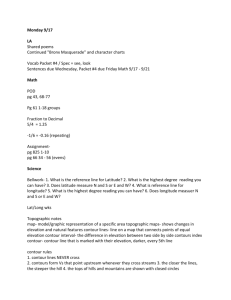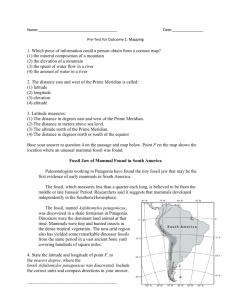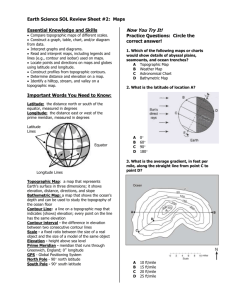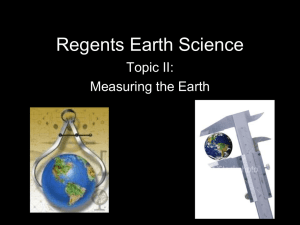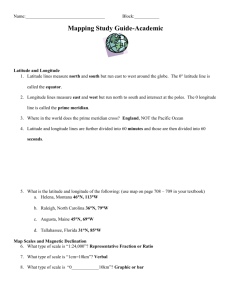Mapping
advertisement
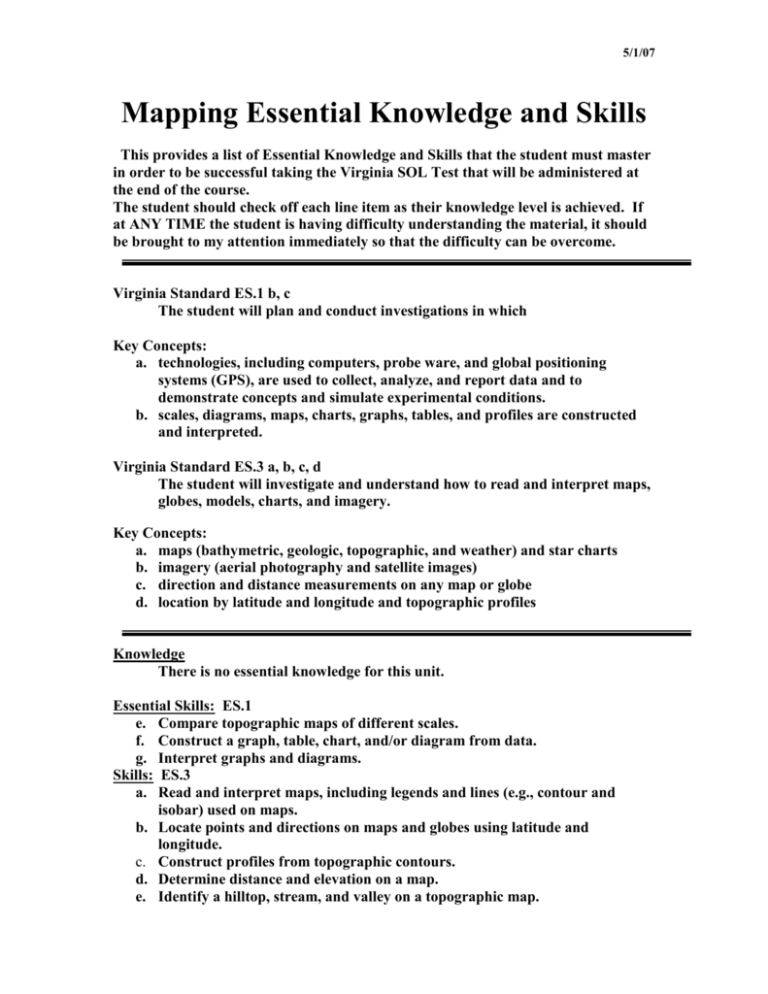
5/1/07 Mapping Essential Knowledge and Skills This provides a list of Essential Knowledge and Skills that the student must master in order to be successful taking the Virginia SOL Test that will be administered at the end of the course. The student should check off each line item as their knowledge level is achieved. If at ANY TIME the student is having difficulty understanding the material, it should be brought to my attention immediately so that the difficulty can be overcome. Virginia Standard ES.1 b, c The student will plan and conduct investigations in which Key Concepts: a. technologies, including computers, probe ware, and global positioning systems (GPS), are used to collect, analyze, and report data and to demonstrate concepts and simulate experimental conditions. b. scales, diagrams, maps, charts, graphs, tables, and profiles are constructed and interpreted. Virginia Standard ES.3 a, b, c, d The student will investigate and understand how to read and interpret maps, globes, models, charts, and imagery. Key Concepts: a. maps (bathymetric, geologic, topographic, and weather) and star charts b. imagery (aerial photography and satellite images) c. direction and distance measurements on any map or globe d. location by latitude and longitude and topographic profiles Knowledge There is no essential knowledge for this unit. Essential Skills: ES.1 e. Compare topographic maps of different scales. f. Construct a graph, table, chart, and/or diagram from data. g. Interpret graphs and diagrams. Skills: ES.3 a. Read and interpret maps, including legends and lines (e.g., contour and isobar) used on maps. b. Locate points and directions on maps and globes using latitude and longitude. c. Construct profiles from topographic contours. d. Determine distance and elevation on a map. e. Identify a hilltop, stream, and valley on a topographic map. Essential Understandings Scale relates to actual distance. Topographic maps, air photos, and satellite images relate to actual 3-D landforms. Grid systems are used to define locations and directions on maps, globes, and charts. SOL Vocabulary These terms were taken directly from the SOL Framework. It is important that teachers and students have a complete understanding of all of the words listed. aerial photography – photographs taken from an aircraft in order to collect data for charts and maps bathymetric map – map that shows the depths and features of the ocean floor chart – an outline map on which special data such as weather information can be plotted; a sheet presenting data in graph or tabular form contour interval – the difference in elevation between two consecutive contour lines contour lines – lines that pass through points on a map that have the same elevation distance – the length of a line segment joining two points elevation – height above sea level geologic map – map that shows features relating to the geology of an area such as rock formations, soil, or time period of rocks globe – a spherical or round model of Earth hilltop – shown on a topographic map by enclosed contour lines with the highest contour line in the middle surrounded by contour lines of lower elevation imaging (computer) – map making using data collected from Landsats and imaging radar landforms – features that make up the topography of an area latitude – the measure of distance north and south of the equator legend – an explanatory accompanying a map, chart, or illustration longitude – the measure of the distance east and west of the prime meridian map – a representation, of all or part, of Earth on a flat surface model – a small object, usually built to scale, that represents a larger object profile – a silhouette of the elevations along a given or base line satellite image – data collected by satellite sensors and sent to ground stations as a stream of numbers where computers turn the data into images of Earth’s surface scale – a fixed ratio between the size of a real object and the size of a model of the same object star chart – a map of the night sky showing the stars and constellations visible, during a particular season, in a given hemisphere stream – a body of running water especially one moving over the earth’s surface in a channel; contour lines bend uphill when they cross a stream topographic map – map that shows the different shapes and sizes of a land surface using contour lines valley – an elongated lowland between mountain ranges, hills, or other uplands, often having a river or stream running along the bottom weather map – a map showing the conditions of the atmosphere for a certain area Additional Related Vocabulary benchmark – a permanent marker in the ground indicating the exact elevation above sea level degree – 1/360 of a circle east – the location of longitude to the right of the prime meridian and to the left of the International Date Line; the direction is right when north is at the top equator – imaginary line around the earth that divided the earth into two hemispheres; parallel located halfway between the north and south poles gradient – the vertical drop in a land area's elevation over a given horizontal distance, expressed as an angle or in feet per mile; average slope calculated as change in elevation divided by change in distance hachure lines – short dashed lines drawn perpendicular to an enclosed contour line which are used to indicate a depression, always point toward lower elevations International Date Line – line located along the 180th meridian; when the line is crossed going west, one day is added; when it is crossed going east, one day is subtracted meridian – line that runs between the points on a globe or map that represent the geographic north and south poles of the earth minute – 1/60 of a degree nautical mile – 1 minute of latitude (slightly larger than a mile) north – the direction of latitude above the equator; usually located at the top of a map unless indicated otherwise north pole – 90 north latitude; points to Polaris, the North Star parallels – lines going from east to west across a map or globe that crosses a meridian at right angles Prime Meridian – meridian that runs through Greenwich, England; 0˚ longitude sea level – level of the surface of the sea midway between the average high and low tides second – 1/60 of a minute slope – a measure of the amount of change in elevation divided by the change in distance; is usually expressed as a percentage but can also be expressed as an angle of elevation south – the direction of latitude below the equator; usually located at the bottom of a map unless indicated otherwise south pole – 90 south latitude west – the location of longitude to the left of the prime meridian and to the right of the International Date Line; the direction is left when north is at the top of the map or observer is facing north x-axis – the horizontal axis on a line or bar graph y-axis – the vertical axis on a line or bar graph zenith – a point in the sky directly above the observer


